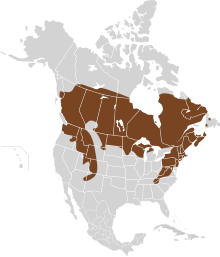| Southern red-backed vole | |
|---|---|

| |
| Scientific classification | |
| Domain: | Eukaryota |
| Kingdom: | Animalia |
| Phylum: | Chordata |
| Class: | Mammalia |
| Order: | Rodentia |
| Family: | Cricetidae |
| Subfamily: | Arvicolinae |
| Genus: | Clethrionomys |
| Species: | C. gapperi
|
| Binomial name | |
| Clethrionomys gapperi (Vigors, 1830)
| |

| |
The southern red-backed vole or Gapper's red-backed vole (Clethrionomys gapperi) is a small slender vole found in Canada and the northern United States. It is closely related to the western red-backed vole (Clethrionomys californius), which lives to the south and west of its range and which is less red with a less sharply bicolored tail.
YouTube Encyclopedic
-
1/1Views:17 753
-
Essential Step in Vole Control - The Apple Sign Test
Transcription
Description
These voles have short slender bodies with a reddish band along the back and a short tail. The sides of the body and head are grey and the underparts are paler. There is a grey color morph in the northeast part of their range. They are 12–16.5 cm (4.7–6.5 in) long with a 4 cm tail[2] and weigh about 6–42 g; average 20.6 g (0.21–1.48 oz; average 0.72 oz).[3] They are active year-round, mostly at night. They use burrows created by other small animals, such as squirrels and groundhogs.
Habitat

These animals are found in coniferous, deciduous, and mixed forests, often near wetlands. They use runways through the surface growth in warm weather and tunnel through the snow in winter. They are omnivorous feeding on green plants, underground fungi, seeds, nuts, roots, also insects, snails, and berries.[2] They store roots, bulbs, and nuts for later use.
Predators
Predators include hawks, owls, and mustelids.
Breeding
Female voles have two to four litters of two to eight young in a year.[2]
References
- ^ Cassola, F. (2017) [errata version of 2016 assessment]. "Myodes gapperi". IUCN Red List of Threatened Species. 2016: e.T42617A115195411. doi:10.2305/IUCN.UK.2016-3.RLTS.T42617A22373314.en.
- ^ a b c Southern Red-backed Vole Archived 2021-04-15 at the Wayback Machine, borealforest.org
- ^ Southern Red-backed Vole, Animal Diversity Web

